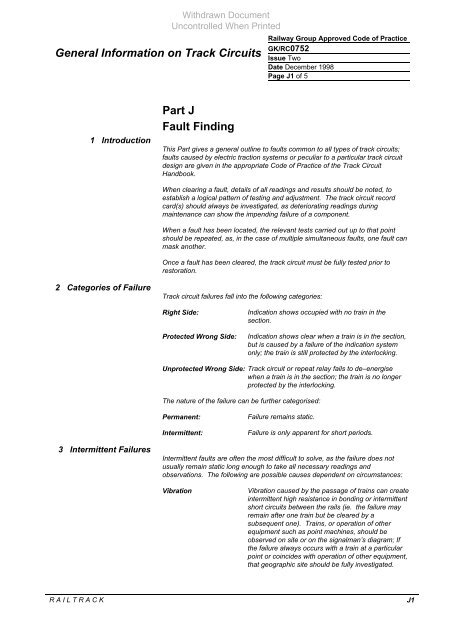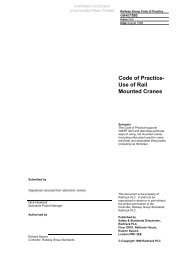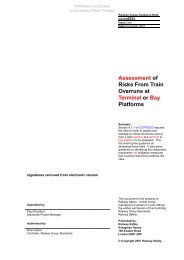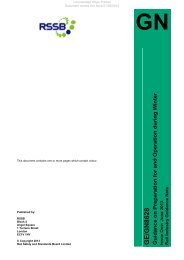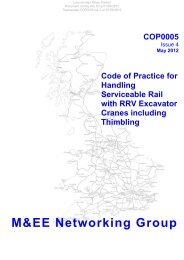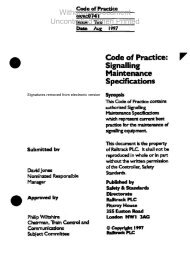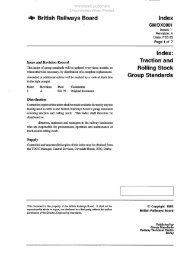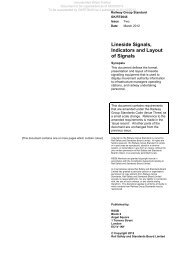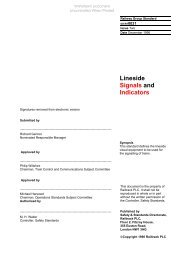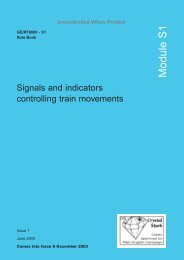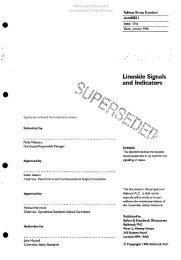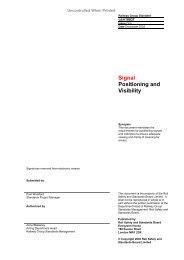General Information on Track Circuits - RGS Online
General Information on Track Circuits - RGS Online
General Information on Track Circuits - RGS Online
You also want an ePaper? Increase the reach of your titles
YUMPU automatically turns print PDFs into web optimized ePapers that Google loves.
<str<strong>on</strong>g>General</str<strong>on</strong>g> <str<strong>on</strong>g>Informati<strong>on</strong></str<strong>on</strong>g> <strong>on</strong> <strong>Track</strong> <strong>Circuits</strong><br />
1 Introducti<strong>on</strong><br />
2 Categories of Failure<br />
3 Intermittent Failures<br />
Withdrawn Document<br />
Unc<strong>on</strong>trolled When Printed<br />
Part J<br />
Fault Finding<br />
Railway Group Approved Code of Practice<br />
GK/RC0752<br />
Issue Two<br />
Date December 1998<br />
Page J1 of 5<br />
This Part gives a general outline to faults comm<strong>on</strong> to all types of track circuits;<br />
faults caused by electric tracti<strong>on</strong> systems or peculiar to a particular track circuit<br />
design are given in the appropriate Code of Practice of the <strong>Track</strong> Circuit<br />
Handbook.<br />
When clearing a fault, details of all readings and results should be noted, to<br />
establish a logical pattern of testing and adjustment. The track circuit record<br />
card(s) should always be investigated, as deteriorating readings during<br />
maintenance can show the impending failure of a comp<strong>on</strong>ent.<br />
When a fault has been located, the relevant tests carried out up to that point<br />
should be repeated, as, in the case of multiple simultaneous faults, <strong>on</strong>e fault can<br />
mask another.<br />
Once a fault has been cleared, the track circuit must be fully tested prior to<br />
restorati<strong>on</strong>.<br />
<strong>Track</strong> circuit failures fall into the following categories:<br />
Right Side: Indicati<strong>on</strong> shows occupied with no train in the<br />
secti<strong>on</strong>.<br />
Protected Wr<strong>on</strong>g Side: Indicati<strong>on</strong> shows clear when a train is in the secti<strong>on</strong>,<br />
but is caused by a failure of the indicati<strong>on</strong> system<br />
<strong>on</strong>ly; the train is still protected by the interlocking.<br />
Unprotected Wr<strong>on</strong>g Side: <strong>Track</strong> circuit or repeat relay fails to de–energise<br />
when a train is in the secti<strong>on</strong>; the train is no l<strong>on</strong>ger<br />
protected by the interlocking.<br />
The nature of the failure can be further categorised:<br />
Permanent: Failure remains static.<br />
Intermittent: Failure is <strong>on</strong>ly apparent for short periods.<br />
Intermittent faults are often the most difficult to solve, as the failure does not<br />
usually remain static l<strong>on</strong>g enough to take all necessary readings and<br />
observati<strong>on</strong>s. The following are possible causes dependent <strong>on</strong> circumstances:<br />
Vibrati<strong>on</strong> Vibrati<strong>on</strong> caused by the passage of trains can create<br />
intermittent high resistance in b<strong>on</strong>ding or intermittent<br />
short circuits between the rails (ie. the failure may<br />
remain after <strong>on</strong>e train but be cleared by a<br />
subsequent <strong>on</strong>e). Trains, or operati<strong>on</strong> of other<br />
equipment such as point machines, should be<br />
observed <strong>on</strong> site or <strong>on</strong> the signalman’s diagram; If<br />
the failure always occurs with a train at a particular<br />
point or coincides with operati<strong>on</strong> of other equipment,<br />
that geographic site should be fully investigated.<br />
R A I L T R A C K J1


